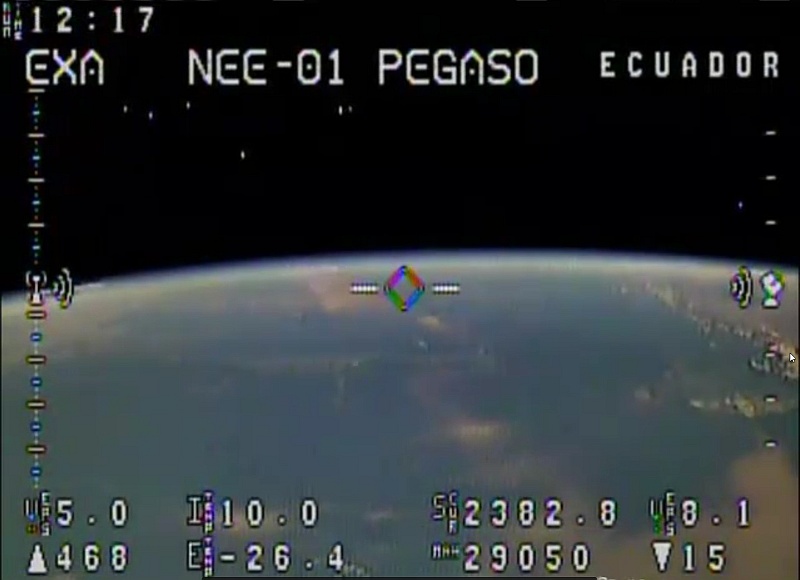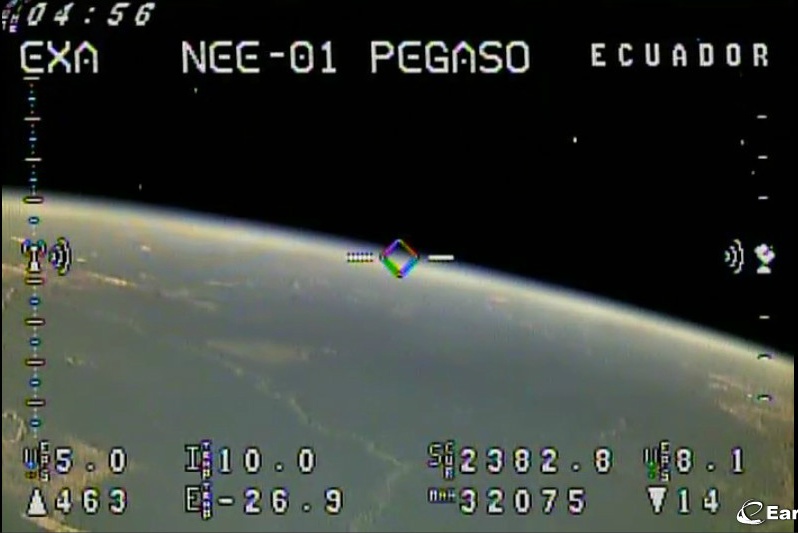The United States Joint Space Operations Center (JSpOC) has identified a predicted conjunction between NEE 01 PEGASUS (SCC# 39151) and SCC# 15890. Primary Object: NEE 01 PEGASUS (SCC# 39151) Secondary Object: SCC# 15890 Time of Closest Approach: 23 MAY 2013 05:38 UTC Overall miss distance: 703 meters Radial (dU) miss distance: -62 meters In-Track (dV) miss distance: -692 meters Cross-track (dW) miss distance: -111 meters Primary Radial Error (U): 16 meters Primary In-Track Error (V): 205 meters Primary Cross-track Error (W): 11 meters Secondary Radial Error (U): 6 meters Secondary In-Track Error (V): 54 meters Secondary Cross-Track Error (W): 7 meters
Category: NEE-01
NEE-01 video and CW

16:02 UTC sunlight counter fix at 00:09 min
...UATORIANO, DISENADO Y CONSTRUIDO EN ECUADOR POR RONNIE NADER, MANUEL URIGUEN, SIDNEY DROUET, RICARDO EU, ALEJANDRO DROUET Y HECTOR CARRION - AGENCIA ESPACIAL CIVIL ECUATORIANA - IN NOMINI EQUATORIA
... *QUIENES FUERON LOS PRIMEROS HOMBRES EN TOCAR SUELO LUNAR? :NEIL ARMSTRONG Y EDW --
PREGUNTA 72 - = QUIENES FUERON LOS TRIPULANTES DEL VOSKH* :ALEXEI LEONOV Y PAVEE --
PREGUNTA 73 - = SE HA POSADO ALGUNA NAVE ESPACIAL SB3STE.. LA SONDAS NEAR Y HAT --
PREGUNTA 74 - = DESPUES DEL PROGRAMA VIKING, CASI DOS DECADAS DESPUES, SE LLEVO A CABO EL LANZAMIENTO DE UNA SEGUNDA NAVE: CUAL FUE SUROMBRE Y EL ANIO? =:MARS PATHFINDE AMARTILO EN JULIO 4 DE 199...
PREGUNTA 75 - = EL 12 DE ABRIL DE 1961, YURI GAGARIN, A BORDO DE UN VOSTOK* DT UNA VUELTA COMPLETA A LA TIERRA. QUE TIEMPO DEMORO EN EVA VUELTA COMPLETA A LA TIERAT? :108 ...
NEE-01 video and CW

15:40 UTC
end of eclipse wa 15:09 UTC – but sunlight timer shows 9:02 min at start of transmission (30 min delay)
--PREGUNTA 26 - = CUANTO PESA EL COHETE DNEPR? :211.0N
--PREGUNTA 27 - = EN QUE ANIO FUE DESARROLLADO EL MODELO DE TRAJE ESPACIAL SOKOL? X :EN 197
--PREGUNTA 28 - = EN QUE FECHA FUE ENVIADA LA PERRA LAIKA AL ES.....
--PREGUNTA 29 - = PORA*OS ASTRONAUTAS PIERDEN PESO? :POR LOS EFECTOS DE LA MICRO GRAVEDA A .... TOLTA DE ESFUERZO .....
--PREGUNTA 30 - =EN QUE FECHA SE LANZO AL ESPACIO LA PRIMERA ESTACION ESPACIAL DENOMINADA SALYUT 1? :ABRIL 19 DE 197...
NEE-01 PEGASO: 1ER SATELITE ECUATORIANO, DISENADANSTRUIDO EN ECUADOR POR RONNIE NADER, MANUEL URIGUEN, SIDNEY DROUET, RICARDO ALLU, ALEJANDRO DROUET Y HECTOR CARRION - AGENCIA ESPACIAL CIVIL ECUATORIANA - IN NOMINI EQUATORIA I...
NEE-01 great video signals and sound
16:05 UTC
SSTV image Mode P7

CW signal
...ANZO EL ESPACIO A UNA ALTURA DE I --PREGUNTA 19 - =CUANDO DESCENDIO EXITOSAMENTE POR PERA VEZ ...A NAVE ESPACIAL SOBRE* :LA SONDA VIKING ...
...PEGASO: JHEIH ** PEGASO: 1ER SATELITE ECUATORIANO, DISENADO Y CONSTRUIDO EN ECUADOR POR RONNIE NADER, MANUEL URIGUEN, SIDNEY DROUET, RICARDO ALLU, ALEJANDRO DROUET Y HECTOA I CARRION - AGENCIA ESPACIAL CIVIL ECUATORIANA
NEE-01 video from space

mission accomplished :-)
OSS Telemetry
Veps = 5.0V The NEREIDA module voltage is nominal
Scur = 2382.8 mA system consumption
mAH = 32075 system consumption since start-up
Veps = 8.1V The CYCLOPS module voltage, a little high, should be 7.5V
I temp = 10.0C this is the internal temperature
E temp = -26.9C is external temp, sensor mounted on the Z- axis, quite cold, implies that sat is not rotating over X axis
Up arrow = 463 means upper solar wing deployed
down arrow = 14 means down solar wing deployed
middle signal indicators means contact with HERMES-A and TX nominal
4:56 min runtime is cyclical counter should start in 0 when satellite gets out of eclipse
NEE-01 PEGASO live broadcast starts May 16
NEE-01 audio signal
19:45 UTC 910 MHz – decoded video signal – maybe there is something …

CZ-2D with Cubesats successfully launched
04:13 UTC successful launch of Long March 2D from Jiuquan launching center in northwest China with NEE-01, TURKSAT 3USAT and CubeBug-1.

09:03 UTC first low 15 deg elevation pass
NEE-01 – nothing heard
TURKSAT-3USAT – CW beacon heard by Wouter, PA3WEG and Nader, ST2NH
CubeBug-1 – nothing heard
new TLE:
TURKSAT 1 12345U 12345A 13116.18500615 .00000000 00000-0 10000-4 0 6 2 12345 98.0372 191.7767 0017397 251.4298 279.4470 14.76467545 04 NEE-01 PEGASO 1 12346U 12346A 13116.18500615 .00000000 00000-0 10000-4 0 8 2 12346 98.0563 191.7735 0017556 248.2772 282.5989 14.76251447 02 CUBEBUG 1 12347U 12347A 13116.18500615 .00000000 00000-0 10000-4 0 0 2 12347 98.0563 191.7735 0017556 248.2772 282.5989 14.76251447 03
TLE NEE-01, Cubebug-1 and Turksat-3USAT
NEE-01 Pegaso
PEGASO 1 12345U 12345A 13116.18513889 .00000000 00000-0 10000-4 0 8 2 12345 98.0611 191.6701 0011357 277.8575 253.6587 14.76861145 07
Downlink 910 MHz video
Cubebug-1
CUBEBUG-1 1 12346U 12346A 13116.18513889 .00000000 00000-0 10000-4 0 0 2 12346 98.0601 183.4980 0011346 277.7754 253.7529 14.76858350 03
Beacon 437445 MHz. AFSK AX.25, 1200 bps
Turksat-3USAT
TURKSAT 3USAT 1 12347U 12347A 13116.18513889 .00000000 00000-0 10000-4 0 2 2 12347 98.0411 191.6722 0011 115 275.8011 255.7282 14.76761586 07
Downlink 435.200 – 435.250 MHz Linear Transponder
Uplink 145.940 – 145.990 MHz Linear Transponder
Beacon 437.225 MHz CW
ECUADORIAN SATELLITES PASSED ALL TESTS AND ARE NOW APPROVED FOR SPACEFLIGHT
Guayaquil, March 6, 2013.- The NEE-01 PEGASO and NEE-02 KRYSAOR Ecuadorian satellites have passed all qualification tests for spaceflight and integration on Chinese and Russian launch vehicles and are ready for launch informed today the Ecuadorian Civilian Space Agency – EXA
Last February, a joint team of EXA and the Ecuadorian Government traveled to the Netherlands carrying the satellites where the main laboratories for spaceflight qualification of ISL/ISIS reside, this is the company that manages the launch opportunities for nanosatellites for Chinese and Russian rockets, the Ecuadorian satellites were subject to all necessary tests for enduring space environment and qualification to board Chinese and Russian launch vehicles, the tests were passed by the satellites without problems.
ISL/ISIS pronounced the satellites passed and gave the Acceptance and Qualification Certification for the NEE-01 PEGASO y NEE-02 KRYSAOR, the first satellites completely designed and developed in Latin-America without any support or foreign help by EXA Ecuadorian engineers and whose launch has been financed by the Ecuadorian Government.
“This is a very important achievement in our history and the history of our region because now our space technology is qualified to board Chinese and Russian launch vehicles and to survive the harsh space environment, the satellites passed all tests with flying colors and a clean bill of health, now we only wait for the launch of the first one, the NEE-01 PEGASO on the first half of May and the second one for the second half of July” said Ronnie Nader, Space Operations Director and leader of the team that built the satellites, Nader is also the first Ecuadorian Cosmonaut.
The first satellite to reach orbit will the NEE-01 PEGASO, onboard a Chinese LM2D rocket, both satellites were designed and built completely on Ecuador using private funding by a team of EXA engineers that worked pro bono to built them, while later the Ecuadorian government joined the project by financing the launch operations and the tests logistics. On May 2011 this team of engineers were awarded the National Congress Medal to Scientific Merit, the highest honor bestowed in the country.
Together, the EXA and the Ecuadorian government will operate the satellites for scientific and educational purposes.
The launch of NEE-01 PEGASO had been planned for November 2012 on board a Russian Dnepr rocket, but such launch was postponed for July this year, which forced the Ecuadorians to apply for a Chinese launcher, however this forced the satellites to be re-qualified and re-tested to higher levels of endurance in order to be able to board any of those rockets, tests that now have been passed successfully by the Ecuadorian engineering, the first in Latin America of national origin without any foreign support or help.
 listen to the complete pass
listen to the complete pass